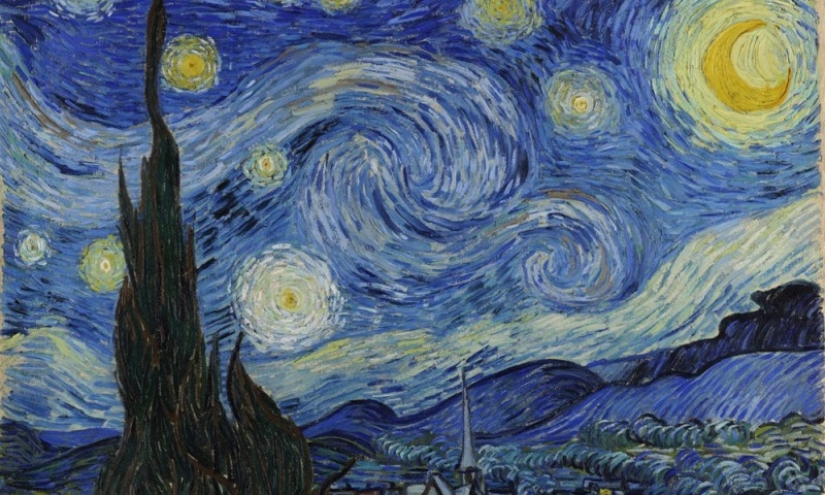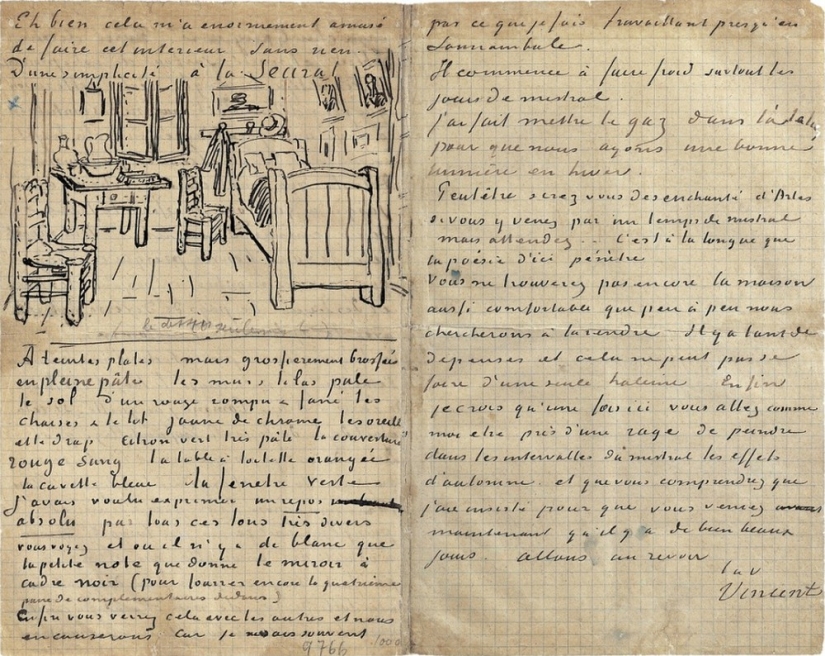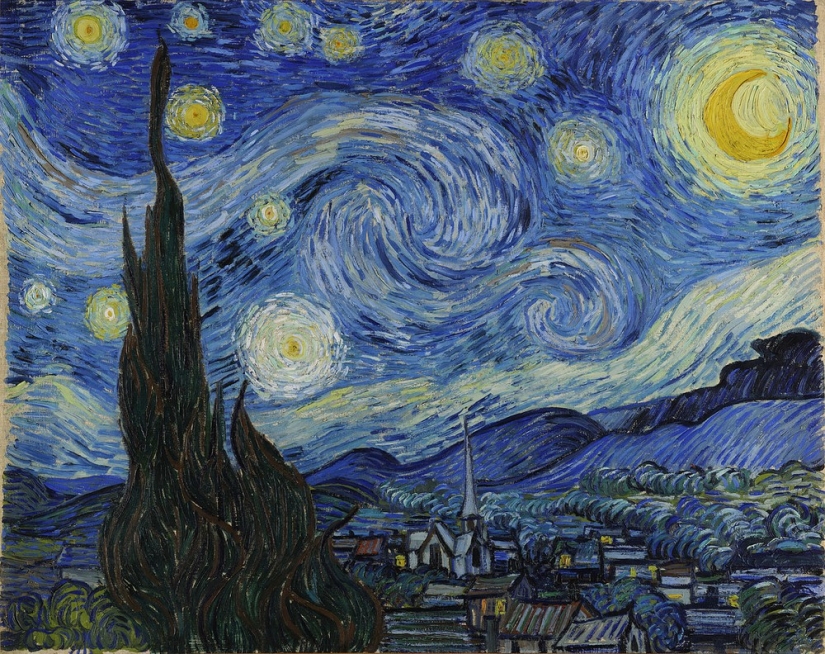Vincent Van Gogh - about the experience of experiencing a mental disorder
Categories: Culture | Health and Medicine
By Pictolic https://pictolic.com/article/vincent-van-gogh-about-the-experience-of-experiencing-a-mental-disorder.htmlVincent Van Gogh is one of those artists whom experts unanimously classify as mentally ill artists. A huge number of works have been written on this subject, the authors of which are psychiatrists and psychoanalysts, art historians and cultural scientists, and even Wikipedia, when asked for "mentally ill artists", gives information about him.

Researchers argue about diagnoses, suggesting that Van Gogh has bipolar disorder, schizophrenia or epilepsy, aggravated by alcohol abuse. But all these diagnoses are only interpretations of a unique ensemble of texts written by Vincent Van Gogh himself.

Few artists, taking up the pen, have left us observations, diaries, letters, the value of which would be comparable to their contribution to the field of painting.

But Van Gogh's letters are a stunning, unlike anything else document, stretching for hundreds of pages, it is a dialogue with the recipients of letters, but also with himself, God, the world.

Without needing intermediaries and translators, Vincent Van Gogh himself tells about his experience of experiencing a mental disorder, presenting himself to readers as an amazing, thinking, hardworking and very sensitive person who, in the periods between bouts of a terrible illness, was much healthier than most of his interpreters and diagnosticians.

The artist's heart-wrenching story about the experience of experiencing a mental disorder begins on January 2, 1889 in a letter addressed to his brother Theo from a psychiatric hospital in the French city of Arles, where Vincent found himself after a well-known incident with a severed ear.


By the way, as a sign of gratitude for the help that Mr. Ray provided to Van Gogh during his bouts of illness, the artist painted his portrait. Contemporaries claimed that the portrait turned out to be very similar to the model, but Felix Ray was indifferent to art. Van Gogh's painting lay in the attic, then for some time they closed the hole in the chicken coop, and only in 1900 (10 years after the artist's death) the painting was found in Dr. Ray's yard. The work was acquired by the famous Russian collector Sergei Shchukin and was kept in his personal collection until 1918. Leaving for immigration, the collector left the painting at home, so it got into the collection of the Pushkin State Museum of Fine Arts in Moscow.

After this first hospitalization, Vincent Van Gogh will write to his brother Theo:

In a letter to his brother Theo dated January 28, 1889, Vincent Van Gogh offers his answer to the question that interests many about the connection between genius and insanity, art and psychopathology:

On February 3, 1889, Vincent Van Gogh makes a curious observation about the residents of the city of Arles - no, not patients of the local psychiatric hospital, but ordinary citizens:

From the artist's letter to his brother dated March 19, 1889, we learn that the residents of Arles appealed to the mayor of the city with a statement signed by some citizens that Van Gogh had no right to live in freedom, after which the police commissioner ordered the artist to be hospitalized again.

On April 21, Vincent van Gogh informs his brother Theo about his decision to settle in a shelter for the mentally ill in Saint-Remy-de-Provence after leaving the hospital:

Vincent Van Gogh's stay in a psychiatric hospital, and later in an asylum for the mentally ill, was financed by the artist's brother, Theo. In addition, for more than 10 years, Theodore provided Vincent with means of livelihood, gave money for rent and studio, for canvases, paints and current expenses. "I do not know of such a medical institution where they would agree to accept me for free on the condition that I will paint at my own expense, and give all my work to the hospital. This is not a big one, but still an injustice. If I had found such a hospital, I would have moved to it without any objections."

Before leaving Arles for the asylum for the mentally ill of Saint-Remy-de-Provence, Vincent Van Gogh writes the following letter to his brother:

Vincent van Gogh spent a year in the Saint-Remy-de-Provence orphanage (from May 1889 to May 1890), the director of the orphanage allowed the artist to work and even provided a separate room for a workshop. Despite repeated seizures, Vincent continued to paint, seeing this as the only way to fight the disease:

In Saint-Remy-de-Provence, the artist paints landscapes depicting views from the studio window and the garden, and when Vincent was allowed to leave the shelter under supervision, the surroundings of Saint-Remy appeared on his canvases.

Despite three severe seizures, which put Vincent out of action for many weeks, he painted more than 150 paintings, made more than 100 drawings and watercolors this year.

From Van Gogh's letter to his sister:

Sincere admiration is caused by Vincent Van Gogh's desire to work, despite his illness, to continue painting and not give up:

It is important to note that Van Gogh was probably the only resident of the shelter who was engaged in the case:

At the end of May 1890, Theo suggested that his brother move closer to him and his family, to which Vincent did not object. After spending three days with Theo in Paris, the artist settles in Auvers-sur-Oise (a small village located near Paris). Here Vincent works, not allowing himself a minute of rest, every day a new work comes out from under his brush. Thus, in the last two months of his life, he creates 70 paintings and 32 drawings.

In Auvers-sur-Oise, Dr. Gachet, who was a specialist in the field of heart diseases and a great lover of art, takes over the supervision of the artist. Vincent will write about this doctor:

Collapsed ... on July 29, 1890, Vincent Van Gogh will pass away, having put a bullet in his chest, he will die in the presence of the summoned doctor Gachet. In the artist's pocket they will find the last letter addressed to Theo Van Gogh, which ends like this:

The death of his older brother will turn into a disaster for Theodore Van Gogh: after an unsuccessful attempt to organize a posthumous exhibition of his brother's paintings, Theo will show signs of insanity, his wife will decide to place the patient in a psychiatric hospital, where he will die on January 21, 1891.

The joint work of the brothers will be highly appreciated posthumously, and it seems an incredible injustice that none of them lived to see the day when world fame and recognition came to Vincent Van Gogh.
The material was prepared with the support of the Center for the Promotion and Development of Creativity of People Suffering from Mental Disorders, Daria Evseeva.
Recent articles

The unkind joke that the task of a hamster is to show a child death is not far from the truth. Scientists conducted research and ...

Gaby Stikler is an amateur photographer from Germany, and her favorite model is the golden retriever Mali, or rather, his nose. You ...

It is hardly worth explaining what a whistle is — we have all been familiar with this simple "musical" instrument since ...